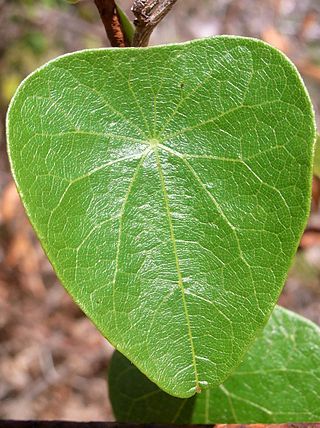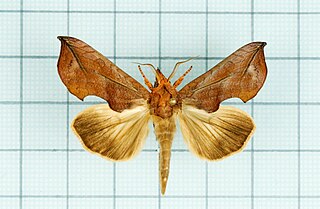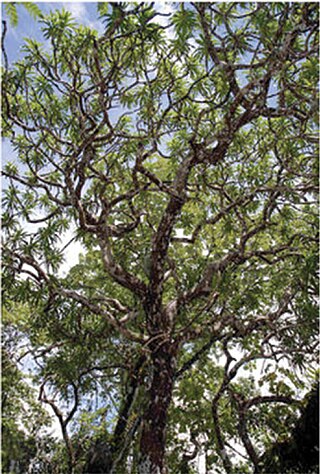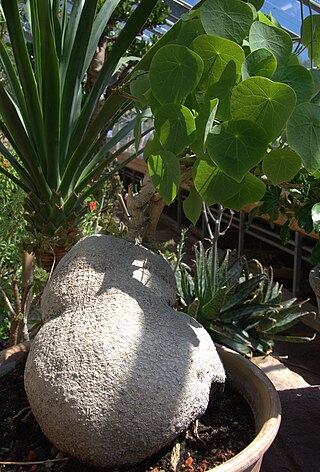
Menispermaceae is a family of flowering plants. The alkaloid tubocurarine, a neuromuscular blocker and the active ingredient in the 'tube curare' form of the dart poison curare, is derived from the South American liana Chondrodendron tomentosum. Several other South American genera belonging to the family have been used to prepare the 'pot' and 'calabash' forms of curare. The family contains 68 genera with some 440 species, which are distributed throughout low-lying tropical areas with some species present in temperate and arid regions.

Saroj Khan was an Indian dance choreographer in Hindi cinema. She was born in Bombay State, India. She was best known for the dance form mujra and the first woman choreographer in Bollywood. With a career spanning over forty years, she choreographed more than 3000 songs. She died on 3 July 2020 of a sudden cardiac arrest.

Stephania is a genus of flowering plants in the family Menispermaceae, native to eastern and southern Asia and Australia. They are herbaceous perennial vines, growing to around four metres tall, with a large tuber. The leaves are arranged spirally on the stem and are peltate, with the leaf petiole attached near the centre of the leaf. The name Stephania comes from the Greek, "a crown". This refers to the anthers being arranged in a crown-like manner.

Phyllanthus mirabilis is a plant species of family Phyllanthaceae and is native to Thailand, Laos and Myanmar. It is one of the only four Phyllanthus to be caudiciform and the one of the only two caudiciform Phyllanthus to be described, with the other being Phyllanthus kaweesakii. The leaves fold together at night. Wild plants are found on limestone mountains and cliffs.
Stephania tetrandra is a herbaceous perennial vine of the family Menispermaceae native to China and Taiwan. It grows from a short, woody caudex, climbing to a height of around three meters. The leaves are arranged spirally on the stem, and are peltate, i.e. with the leaf petiole attached near the centre of the leaf. Its root is used in traditional Chinese medicine (TCM).
Stephania is a genus of flowering plants in the family Menispermaceae.

Stephania japonica, known as snake vine, is a vine often seen in sheltered areas near the sea.

Oraesia excavata is a species of moth of the family Erebidae first described by Arthur Gardiner Butler in 1878. It is found in Japan, Korea, China, Thailand and Taiwan and has recently been recorded from Hawaii.
Stephania crebra is a herbaceous perennial vine in the genus Stephania of the family Menispermaceae. It is native to Southeast Asia and was first described in Thailand in 1988 by L. L. Forman. It is one of 15 Stephania found only in northern Thailand, specifically in the province of Chiang Mai. It has leaves 12–17 cm (4.7–6.7 in) long and 9–16 cm (3.5–6.3 in) wide. It resembles Stephania reticulata but S. crebra has larger flowers but smaller drupes and endocarps.
Lewis Leonard Forman was a British botanist, born in London. He was an expert on spermatophytes, particularly Menispermaceae, and specialised in the plants of Southeast Asia. He graduated from the University of London in 1950 and was appointed to the staff of the Royal Botanic Gardens, Kew in 1951, serving as a senior official there from 1966 to 1989.
Stephania tomentella is a herbaceous perennial vine of the family Menispermaceae and genus Stephania. It is native to Southeast Asia and was first described in Thailand in 1988 by L. L. Forman. It is one of 15 Stephania found only in northern Thailand, specifically in the area around Chiang Rai. It has leaves measuring 7–9 cm (2.8–3.5 in) in both width and length. It is commonly found amongst limestone rocks.

Dracaena kaweesakii is a species of dragon tree. It can reach 12 metres (39 ft) in both height and crown diameter. It is only found growing atop the limestone mountains in the Loei and the Lop Buri Provinces of Thailand.
Plants with the common name snake vine include:

Nepenthes diabolica is a tropical pitcher plant known only from a single mountain in Central Sulawesi, where it occurs at c. 2200–2300 m above sea level. It is characterised by an exceptionally developed peristome and conspicuous, woolly pitcher indumentum. Morphologically it is closest to N. hamata, the only other species from Sulawesi with a similarly elaborated peristome.

Stephania suberosa is a shrub native to Thailand, described by Lewis Leonard Forman in 1980.

Stephania cephalantha is a plant in the genus Stephania of the family Menispermaceae native to China, Taiwan and Vietnam.
Stephania tuberosa is a plant in the family Menispermaceae which is endemic to Queensland. It grows as a vine with a stem diameter of up to 5 cm (2.0 in) and produces a distinctive large tuber on the ground which can be up to 50 cm (20 in) diameter.

Stephania abyssinica is a species of vine native to southern Africa. it is the only member of its genus found in the region. Two subspecies are recognised.
Stephania pierrei, also known as Stephania erecta or binh voi in Vietnamese, is a caudiciform vine native to the Indo-Chinese Peninsula. It is cultivated as a houseplant; in commerce it is typically described as Stephania erecta. It was first described by Ludwig Diels in 1910. The root or caudex is used medicinally in Vietnam; the 2006 Vietnam Red List of Medicinal Plants lists Stephania pierrei as a vulnerable species within the country.










